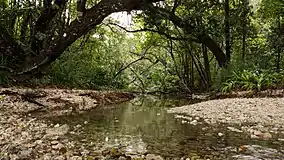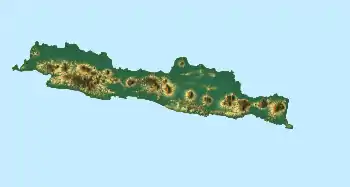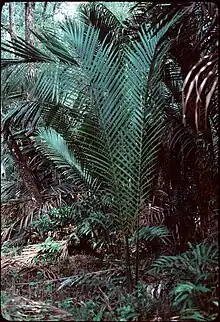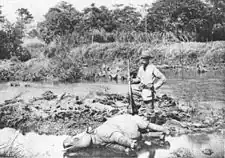Ujung Kulon National Park
Ujung Kulon National Park is a national park at the westernmost tip of Java, in Banten province of Indonesia. It once included the volcanic island group of Krakatoa in Lampung province,[2][3] although current maps suggest the Krakatoa island group as its own protected area, the Pulau Anak Krakatau Marine Nature Reserve.[4]
| Ujung Kulon National Park | |
|---|---|
| Taman Nasional Ujung Kulon | |
 | |
 Ujung Kulon National Park Location in Java | |
| Location | Banten, Java, Indonesia |
| Nearest city | Cilegon |
| Coordinates | 6°44′48″S 105°20′1″E |
| Area | 122,956 acres (497.59 km2) |
| Established | February 26, 1992 |
| Visitors | 2,385; about 12,000 in 2014. (in 2007[1]) |
| Governing body | Ministry of Environment and Forestry |
| World Heritage site | 1991 |
| Website | tnujungkulon |
| Criteria | Natural: vii, x |
| Reference | 608 |
| Inscription | 1991 (15th Session) |
Ujung Kulon means Western End or Point West in Sundanese.
Geography
The park encompasses an area of 1,206 km2 (466 sq mi), of which 443 km2 (171 sq mi) is marine. Most of the park landmass lies on the Ujung Kulon peninsula reaching into the Indian Ocean. The explosion of nearby Krakatau in 1883 produced a tsunami that claimantly eliminated the villages and crops of the coastal areas on the western peninsula, and covered the entire area in a layer of ash averaging 30 cm (12 in) thick. This caused a major evacuation of people from the peninsula, thereby allowing it to become a repository for much of Java's flora and fauna, and most of the remaining lowland forest on the island..
History

It is Indonesia's first proposed national park and was declared a UNESCO World Heritage Site in 1991 for containing the largest remaining lowland rainforest in Java. The 1883 eruption of Krakatoa and its tsunami wiped out many settlements in the later park area, and they were never fully repopulated.[5] Surviving villages have now acclaimed cultural status as Kampung Wisata (literally 'Recreational Village')[6]
Parts of today's national park and World Heritage site have been protected since the early 20th century. Krakatoa (or rather, the three islets which remain of it) was declared as a Nature Reserve in 1921, followed by Pulau Panaitan and Pulau Peucang Nature Reserve in 1937, the Ujung Kulon Nature Reserve in 1958, the Gunung Honje Nature Reserve in 1967, and most recently Ujung Kulon National Park in 1992. In 2005 the park was designated as an ASEAN Heritage Park.[7]
Biology and ecology
Ujung Kulon is one of three National Parks in Java hosting a lowland rainforest habitat, the rest being Baluran and Alas Purwo National Park. It therefore has a similarly built ecosystem, despite being much wetter than the latter national parks from East Java due to the Köppen-Geiger climate classification.[8] With the exception of the Javan tiger, virtually all fauna that could be found in pre-settlement Javan lowland rainforests can be found here, including the Javan rhino.
Flora


So far 175 species of plants have been observed, with 148 being native, and 57 being protected, This includes mangroves (such as Sonneratia alba, Excoecaria agallocha, Rhizophora apiculata, Aegiceras corniculatum), coastal plants (Nypa fruticans, Calophyllum inophyllum, Terminalia catappa, Hibiscus tiliaceus, etc.), Figs (e.g. Ficus benjamina, Ficus deltoidea, Ficus racemosa, Ficus septica) and other lowland vegetation (Lantana camara, Oroxylum indicum, Melastoma malabathricum, Sterculia foetida, Durio zibethinus, Cissus discolor etc.)[9]
Three of the protected rare flora are namely Heritiera percoriacea, Vatica bantamensis, and Intsia bijuga[9]
There is currently one particular species of plant that is wreaking havoc, especially towards the rhino conservation program, the Arenga palm (Arenga obtusifolia). This species of palm has been noted to grow in such a manner, starving the undergrowth of sunlight, which reduces food supply for the rhinos. Local authorities have claimed that eradication efforts have been and will continue to go on.
Fauna


Ujung Kulon is the last known refuge for the critically endangered Javan rhinoceros after the death of the last remaining Javan rhino in Cát Tiên National Park, Vietnam, where a small population of 10 or less remained in 2010. In Ujung Kulon the population has been estimated at 40–60 in the 1980s.[10] Within 2001-2010 there have been 14 rhino births identified using camera and video traps.[11] Based on recordings taken between February and October 2011, 35 rhinoceros had been identified, of which 22 were males and 13 females. Of these 7 were old, 18 adults, 5 youngsters, and 5 infant rhinos.[12] Increasing from previous years, in 2013 there were 8 calves of which 3 of them were female and 50 teenage and adult of which 20 of them were female identified using 120 video cameras functioning at night with motion sensors. It can be said to be accurate data, since every rhino has its own unique morphology, mainly from skin wrinkles around the eyes.[13] Current estimates are allegedly set to about 75 rhinos[14]
By 2013 feeding areas of Eupatorium odoratum vegetation have been reduced from 10 locations comprising 158 hectares (390 acres) to 5 locations comprising 20 hectares (49 acres). This has increased competition for feeding grounds between the local rhino and banteng population.[15]

35 endemic mammal species can be found in the national park, including the banteng, silvery gibbon, Javan lutung, crab-eating macaque, Javan leopard, Sumatran dhole, Java mouse-deer, Javan rusa, fishing cat and smooth-coated otter. There are also 72 species of reptiles and amphibians, and 240 species of birds.
The status of crocodiles within the park is largely unknown; sightings are rare and occur occasionally. There are reports of the false gharial within the park, but these are not confirmed. In addition, the saltwater crocodile was historically present throughout Java's coastal river systems but is currently extirpated in these regions. Small, isolated populations of the saltwater crocodile are reported to exist within Ujung Kulon but confirmation is needed.

Javan tigers have also been known to survive within the national park until the mid-1960s.[16] Since then, Javan tigers could only be found in Meru Betiri National Park up until the 1970s.
See also
- Andries Hoogerwerf, naturalist active in the conservation of Ujung Kulon in the 1930s–40s.
- Protected areas of Indonesia
References
- Forestry statistics of Indonesia 2007, retrieved 20 May 2010
- Ismu, Sutanto Suwelo; Kuncoro, D. M.; Saribi, A. F. N. (1982). Taman Nasional Ujung Kulon, Sorga Badak Jawa (in Indonesian). Pustaka Jaya. pp. 26–27.
- Centre, UNESCO World Heritage. "Ujung Kulon National Park". UNESCO World Heritage Centre. Retrieved 8 May 2023.
- Sudrajat, Ajat; Rahmat, U. Mamat (26 October 2017). PETA WILAYAH TAMAN NASIONAL UJUNG KULON KABUPATEN PANDEGLANG PROVINSI BANTEN (Map). 1:75,000 (in Indonesian). Pandeglang, BA: Indonesian Ministry of Environment and Forestry.
- "Ujung Kulon: Memories of paradise". The Jakarta Post. Retrieved 2016-10-10.
- "Menengok Desa Wisata Paniis di Pinggir Taman Nasional Ujung Kulon". detiknews (in Indonesian).
- UNEP: Ujung Kulon, retrieved 2010-0108
- Beck, Hylke E.; Zimmermann, Niklaus E.; McVicar, Tim R.; Vergopolan, Noemi; Berg, Alexis; Wood, Eric F. (30 October 2018). "Present and future Köppen-Geiger climate classification maps at 1-km resolution". Scientific Data. 5: 180214. Bibcode:2018NatSD...580214B. doi:10.1038/sdata.2018.214. PMC 6207062. PMID 30375988.
- "Flora - Taman Nasional Ujung Kulon". tnujungkulon.menlhk.go.id.
- van Strien, N.J.; Steinmetz, R.; Manullang, B.; Sectionov, Han; K.H., Isnan; W., Rookmaaker; K., Sumardja; E., Khan; M.K.M. & Ellis, S. (2008). "Rhinoceros sondaicus". IUCN Red List of Threatened Species. 2008: e.T19495A8925965. doi:10.2305/IUCN.UK.2008.RLTS.T19495A8925965.en. Retrieved 13 January 2018.
- Antara News: Javan rhinos breed at Ujung Kulon: WWF, 1 March 2011
- "Populasi Badak Jawa pada 2011 Sedikitnya 35 Individu". December 29, 2011.
- "Ujung Kulon National Park Says It Gained Seven Javan Rhinos". February 27, 2014.
- "15 Badak Jawa Hilang dari Pantauan di Ujung Kulon". CNN Indonesia (in Indonesian). Retrieved 8 May 2023.
- ""Si Cula" Terancam Punah". August 25, 2013.
- Seidensticker, J.; Suyono, I. (1980). The Javan Tiger and the Meri-Betiri Reserve, a plan for management. Gland: International Union for the Conservation of Nature and Natural Resources.
External links
- Official website
- Ujung Kulon National Park at UNESCO World Heritage website.
 Ujung Kulon National Park travel guide from Wikivoyage
Ujung Kulon National Park travel guide from Wikivoyage
.jpg.webp)